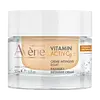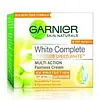Avène Vitamin Activ Cg Radiance Intensive Cream Versus Garnier White Complete Multi Action Fairness Cream
What's inside
What's inside
 Key Ingredients
Key Ingredients

 Benefits
Benefits

 Concerns
Concerns

 Ingredients Side-by-side
Ingredients Side-by-side

Water
Skin ConditioningCaprylic/Capric Triglyceride
MaskingGlycerin
HumectantNiacinamide
SmoothingCarthamus Tinctorius Seed Oil
MaskingButyrospermum Parkii Butter
Skin ConditioningGlycol Palmitate
EmulsifyingAscorbyl Glucoside
AntioxidantArachidyl Alcohol
EmollientCetearyl Alcohol
EmollientGlyceryl Stearate
EmollientArachidyl Glucoside
EmulsifyingBehenyl Alcohol
EmollientCaprylyl Glycol
EmollientCetearyl Glucoside
EmulsifyingCitric Acid
BufferingParfum
MaskingHelianthus Annuus Seed Oil
EmollientSodium Benzoate
MaskingSodium Citrate
BufferingSodium Hyaluronate
HumectantSodium Hydroxide
BufferingSodium Stearoyl Glutamate
CleansingTocopherol
AntioxidantXanthan Gum
EmulsifyingWater, Caprylic/Capric Triglyceride, Glycerin, Niacinamide, Carthamus Tinctorius Seed Oil, Butyrospermum Parkii Butter, Glycol Palmitate, Ascorbyl Glucoside, Arachidyl Alcohol, Cetearyl Alcohol, Glyceryl Stearate, Arachidyl Glucoside, Behenyl Alcohol, Caprylyl Glycol, Cetearyl Glucoside, Citric Acid, Parfum, Helianthus Annuus Seed Oil, Sodium Benzoate, Sodium Citrate, Sodium Hyaluronate, Sodium Hydroxide, Sodium Stearoyl Glutamate, Tocopherol, Xanthan Gum
Water
Skin ConditioningHomosalate
Skin ConditioningPropylene Glycol
HumectantNiacinamide
SmoothingAlcohol
AntimicrobialCI 77891
Cosmetic ColorantDimethicone
EmollientOctocrylene
UV AbsorberButyl Methoxydibenzoylmethane
UV AbsorberTriethanolamine
BufferingPhenylbenzimidazole Sulfonic Acid
UV AbsorberPEG-100 Stearate
PEG-30 Dipolyhydroxystearate
EmulsifyingCera Alba
EmollientPotassium Cetyl Phosphate
EmulsifyingLinalool
PerfumingGeraniol
PerfumingGlyceryl Stearate
EmollientTrideceth-6
EmulsifyingParfum
MaskingPerfluorooctyl Triethoxysilane
Silica
AbrasiveActinidia Chinensis Fruit
Skin ConditioningSodium Citrate
BufferingPerlite
AbsorbentAluminum Hydroxide
EmollientPhenoxyethanol
PreservativeAmmonium Polyacryloyldimethyl Taurate
Emulsion StabilisingChlorphenesin
AntimicrobialTocopherol
AntioxidantAscorbyl Glucoside
AntioxidantLimonene
PerfumingTetrasodium EDTA
Capryloyl Salicylic Acid
ExfoliatingCitrus Limon Fruit Extract
MaskingCitrus Grandis Fruit Extract
AstringentCitral
PerfumingCitrus Junos Fruit Extract
Skin ConditioningMaltodextrin
AbsorbentOctyldodecanol
EmollientAcrylates/C10-30 Alkyl Acrylate Crosspolymer
Emulsion StabilisingBenzyl Salicylate
PerfumingBenzyl Alcohol
PerfumingWater, Homosalate, Propylene Glycol, Niacinamide, Alcohol, CI 77891, Dimethicone, Octocrylene, Butyl Methoxydibenzoylmethane, Triethanolamine, Phenylbenzimidazole Sulfonic Acid, PEG-100 Stearate, PEG-30 Dipolyhydroxystearate, Cera Alba, Potassium Cetyl Phosphate, Linalool, Geraniol, Glyceryl Stearate, Trideceth-6, Parfum, Perfluorooctyl Triethoxysilane, Silica, Actinidia Chinensis Fruit, Sodium Citrate, Perlite, Aluminum Hydroxide, Phenoxyethanol, Ammonium Polyacryloyldimethyl Taurate, Chlorphenesin, Tocopherol, Ascorbyl Glucoside, Limonene, Tetrasodium EDTA, Capryloyl Salicylic Acid, Citrus Limon Fruit Extract, Citrus Grandis Fruit Extract, Citral, Citrus Junos Fruit Extract, Maltodextrin, Octyldodecanol, Acrylates/C10-30 Alkyl Acrylate Crosspolymer, Benzyl Salicylate, Benzyl Alcohol
Ingredients Explained
These ingredients are found in both products.
Ingredients higher up in an ingredient list are typically present in a larger amount.
Ascorbyl Glucoside is a stable form of Vitamin C. It is created by combining glucose from starch.
When applied to skin, Ascorbyl Glucoside turns into Ascorbic Acid.
Ascorbyl Glucoside is an antioxidant. Antioxidants help fight free-radicals, or molecules that may damage skin cells.
It can help to reduce redness, improve skin texture, reduce the effects of aging, reduce the visibility of dark spots, and brighten skin.
Read more about other types of Vitamin C:
Learn more about Ascorbyl GlucosideGlyceryl Stearate is a mix of glycerin and stearic acid.
It is used to stabilize the mixing of water and oil ingredients. By preventing these ingredients from separating, it can help elongate shelf life. It can also help thicken the product's texture.
As an emollient, it helps soften skin and supports barrier-replenishing ingredients.
In cosmetics, Glyceryl Stearate is often made from vegetable oils or synthetically produced.
This ingredient may not be fungal-acne safe
Fun fact: The human body also creates Glyceryl Stearate naturally.
Learn more about Glyceryl StearateNiacinamide is a multitasking form of vitamin B3 that strengthens the skin barrier, reduces pores and dark spots, regulates oil, and improves signs of aging.
And the best part? It's gentle and well-tolerated by most skin types, including sensitive and reactive skin.
You might have heard of "niacin flush", or the reddening of skin that causes itchiness. Niacinamide has not been found to cause this.
In very rare cases, some individuals may not be able to tolerate niacinamide at all or experience an allergic reaction to it.
If you are experiencing flaking, irritation, and dryness with this ingredient, be sure to double check all your products as this ingredient can be found in all categories of skincare.
When incorporating niacinamide into your routine, look out for concentration amounts. Typically, 5% niacinamide provides benefits such as fading dark spots. However, if you have sensitive skin, it is better to begin with a smaller concentration.
When you apply niacinamide to your skin, your body converts it into nicotinamide adenine dinucleotide (NAD). NAD is an essential coenzyme that is already found in your cells as "fuel" and powers countless biological processes.
In your skin, NAD helps repair cell damage, produce new healthy cells, support collagen production, strengthen the skin barrier, and fight environmental stressors (like UV and pollution).
Our natural NAD levels start to decline with age, leading to slower skin repair, visible aging, and a weaker skin barrier. By providing your skin niacinamide, you're recharging your skin's NAD levels. This leads to stronger, healthier, and younger looking skin.
Another name for vitamin B3 is nicotinamide. This vitamin is water-soluble and our bodies don't store it. We obtain Vitamin B3 from either food or skincare. Meat, fish, wheat, yeast, and leafy greens contain vitamin B3.
The type of niacinamide used in skincare is synthetically created.
Learn more about NiacinamideParfum is a catch-all term for an ingredient or more that is used to give a scent to products.
Also called "fragrance", this ingredient can be a blend of hundreds of chemicals or plant oils. This means every product with "fragrance" or "parfum" in the ingredients list is a different mixture.
For instance, Habanolide is a proprietary trade name for a specific aroma chemical. When used as a fragrance ingredient in cosmetics, most aroma chemicals fall under the broad labeling category of “FRAGRANCE” or “PARFUM” according to EU and US regulations.
The term 'parfum' or 'fragrance' is not regulated in many countries. In many cases, it is up to the brand to define this term.
For instance, many brands choose to label themselves as "fragrance-free" because they are not using synthetic fragrances. However, their products may still contain ingredients such as essential oils that are considered a fragrance by INCI standards.
One example is Calendula flower extract. Calendula is an essential oil that still imparts a scent or 'fragrance'.
Depending on the blend, the ingredients in the mixture can cause allergies and sensitivities on the skin. Some ingredients that are known EU allergens include linalool and citronellol.
Parfum can also be used to mask or cover an unpleasant scent.
The bottom line is: not all fragrances/parfum/ingredients are created equally. If you are worried about fragrances, we recommend taking a closer look at an ingredient. And of course, we always recommend speaking with a professional.
Learn more about ParfumSodium Citrate is the sodium salts of citric acid. In skincare, it is used to alter pH levels and acts as a preservative.
Its main functions are to maintain the pH of a product and neutralize metal ions.
The acidity of our skin is maintained by our glands and skin biome; normal pH level of skin is slightly acidic (~4.75-5.5).
Being slightly acidic allows our skin to create an "acid mantle". This acid mantle is a thin barrier that protects our skin from bacteria and contaminants.
Learn more about Sodium CitrateTocopherol (also known as Vitamin E) is a common antioxidant used to help protect the skin from free-radicals and strengthen the skin barrier. It's also fat soluble - this means our skin is great at absorbing it.
Vitamin E also helps keep your natural skin lipids healthy. Your lipid skin barrier naturally consists of lipids, ceramides, and fatty acids. Vitamin E offers extra protection for your skin’s lipid barrier, keeping your skin healthy and nourished.
Another benefit is a bit of UV protection. Vitamin E helps reduce the damage caused by UVB rays. (It should not replace your sunscreen). Combining it with Vitamin C can decrease sunburned cells and hyperpigmentation after UV exposure.
You might have noticed Vitamin E + C often paired together. This is because it is great at stabilizing Vitamin C. Using the two together helps increase the effectiveness of both ingredients.
There are often claims that Vitamin E can reduce/prevent scarring, but these claims haven't been confirmed by scientific research.
Learn more about TocopherolWater. It's the most common cosmetic ingredient of all. You'll usually see it at the top of ingredient lists, meaning that it makes up the largest part of the product.
So why is it so popular? Water most often acts as a solvent - this means that it helps dissolve other ingredients into the formulation.
You'll also recognize water as that liquid we all need to stay alive. If you see this, drink a glass of water. Stay hydrated!
Learn more about Water